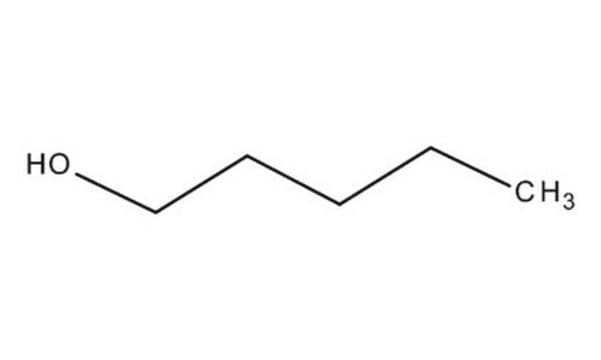W205605
Amyl alcohol
≥99%, FG
Synonym(s):
1-Pentanol, n-Amyl alcohol, Pentyl alcohol
About This Item
Recommended Products
biological source
synthetic
grade
FG
Fragrance grade
Agency
follows IFRA guidelines
meets purity specifications of JECFA
reg. compliance
EU Regulation 1223/2009
EU Regulation 1334/2008 & 872/2012
FDA 21 CFR 172.515
FDA 21 CFR 176.180
FDA 21 CFR 176.210
vapor density
3 (vs air)
vapor pressure
1 mmHg ( 13.6 °C)
1.5 mmHg ( 20 °C)
Assay
≥99%
form
liquid
autoignition temp.
572 °F
expl. lim.
10 %, 100 °F
refractive index
n20/D 1.409 (lit.)
bp
136-138 °C (lit.)
mp
−78 °C (lit.)
density
0.811 g/mL at 25 °C (lit.)
application(s)
flavors and fragrances
Documentation
see Safety & Documentation for available documents
food allergen
no known allergens
fragrance allergen
no known allergens
Organoleptic
pungent; chemical; wine-like
SMILES string
CCCCCO
InChI
1S/C5H12O/c1-2-3-4-5-6/h6H,2-5H2,1H3
InChI key
AMQJEAYHLZJPGS-UHFFFAOYSA-N
Looking for similar products? Visit Product Comparison Guide
General description
Application
- Process-specified emission factors and characteristics of VOCs from the auto-repair painting industry.: This article evaluates the emission factors and characteristics of various volatile organic compounds, including amyl alcohol, in auto-repair painting, significant for environmental biochemistry and safety assessments (Xiao et al., 2024).
Signal Word
Danger
Hazard Statements
Precautionary Statements
Hazard Classifications
Acute Tox. 4 Inhalation - Eye Dam. 1 - Flam. Liq. 3 - Skin Irrit. 2 - STOT SE 3
Target Organs
Respiratory system
Storage Class Code
3 - Flammable liquids
WGK
WGK 1
Flash Point(F)
120.2 °F - closed cup
Flash Point(C)
49 °C - closed cup
Personal Protective Equipment
Certificates of Analysis (COA)
Search for Certificates of Analysis (COA) by entering the products Lot/Batch Number. Lot and Batch Numbers can be found on a product’s label following the words ‘Lot’ or ‘Batch’.
Already Own This Product?
Find documentation for the products that you have recently purchased in the Document Library.
Customers Also Viewed
Our team of scientists has experience in all areas of research including Life Science, Material Science, Chemical Synthesis, Chromatography, Analytical and many others.
Contact Technical Service













